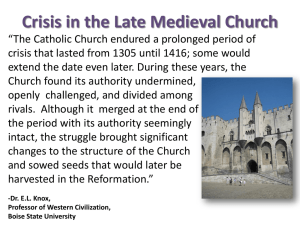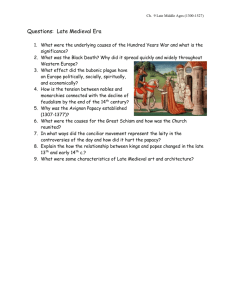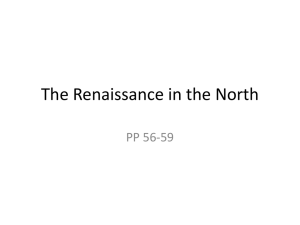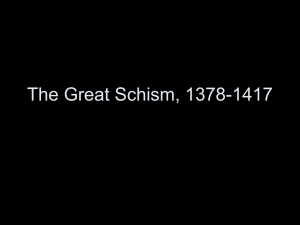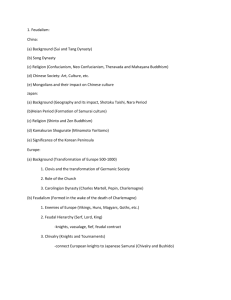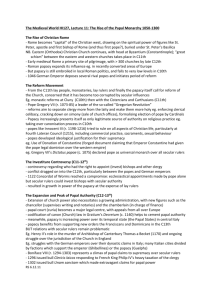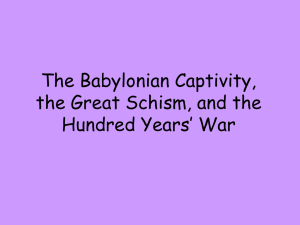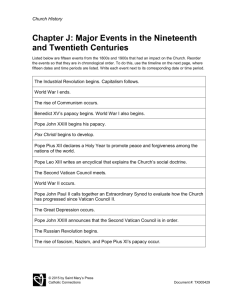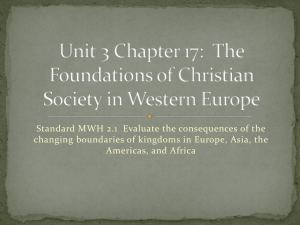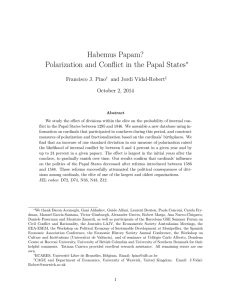A Great Cloud of Witnesses - St. Michael Catholic Church
advertisement
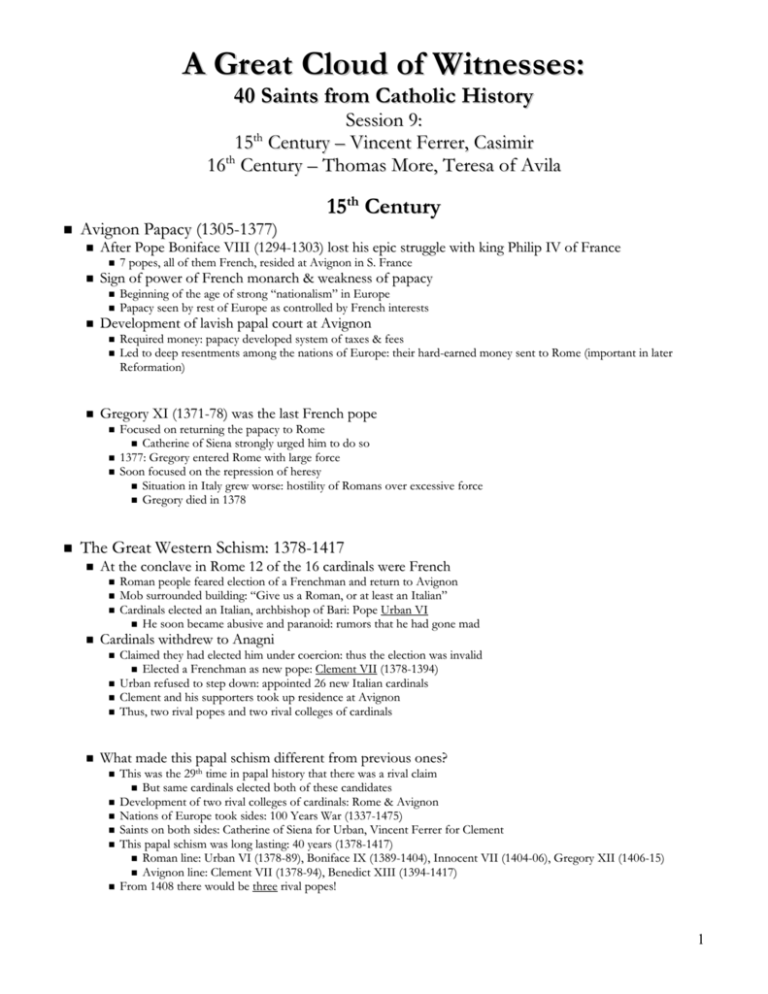
A Great Cloud of Witnesses: 40 Saints from Catholic History Session 9: 15 Century – Vincent Ferrer, Casimir th 16 Century – Thomas More, Teresa of Avila th Avignon Papacy (1305-1377) After Pope Boniface VIII (1294-1303) lost his epic struggle with king Philip IV of France Sign of power of French monarch & weakness of papacy 7 popes, all of them French, resided at Avignon in S. France Beginning of the age of strong “nationalism” in Europe Papacy seen by rest of Europe as controlled by French interests Development of lavish papal court at Avignon Required money: papacy developed system of taxes & fees Led to deep resentments among the nations of Europe: their hard-earned money sent to Rome (important in later Reformation) Gregory XI (1371-78) was the last French pope 15th Century Focused on returning the papacy to Rome Catherine of Siena strongly urged him to do so 1377: Gregory entered Rome with large force Soon focused on the repression of heresy Situation in Italy grew worse: hostility of Romans over excessive force Gregory died in 1378 The Great Western Schism: 1378-1417 At the conclave in Rome 12 of the 16 cardinals were French Cardinals withdrew to Anagni Roman people feared election of a Frenchman and return to Avignon Mob surrounded building: “Give us a Roman, or at least an Italian” Cardinals elected an Italian, archbishop of Bari: Pope Urban VI He soon became abusive and paranoid: rumors that he had gone mad Claimed they had elected him under coercion: thus the election was invalid Elected a Frenchman as new pope: Clement VII (1378-1394) Urban refused to step down: appointed 26 new Italian cardinals Clement and his supporters took up residence at Avignon Thus, two rival popes and two rival colleges of cardinals What made this papal schism different from previous ones? This was the 29th time in papal history that there was a rival claim But same cardinals elected both of these candidates Development of two rival colleges of cardinals: Rome & Avignon Nations of Europe took sides: 100 Years War (1337-1475) Saints on both sides: Catherine of Siena for Urban, Vincent Ferrer for Clement This papal schism was long lasting: 40 years (1378-1417) Roman line: Urban VI (1378-89), Boniface IX (1389-1404), Innocent VII (1404-06), Gregory XII (1406-15) Avignon line: Clement VII (1378-94), Benedict XIII (1394-1417) From 1408 there would be three rival popes! 1 The universities took the lead in seeking resolution Meanwhile, Christendom grew weary of this scandal Both Gregory XII & Benedict XIII refused to attend Yet the council had the backing of most of the courts of Europe Rather than try to determine legitimate pope, it deposed both An Italian was then elected as Alexander V: but he died within the year Meanwhile both Gregory & Benedict continued to claim legitimacy Cardinals at Pisa elected John XXIII (1410-15) to succeed Alexander He was politically conniving and morally corrupt: unable to command the allegiance of Europe and lead the papacy out of schism Thus, in 1410 there were now three rival popes Roman cardinals exasperated, began negotiating with Avignon party 1409: The “Council” of Pisa But ancient canonical principle: “Pope is judged by no one” Drastic times demand drastic measures: 1) Gather an army and force one pope to abdicate? 2) Convince both to abdicate & elect new pope? 3) Call a general council to resolve the matter John XXIII got into political trouble in Italy: had to flee and seek help from the German Emperor, Sigismund He offered John protection on condition that he call a general council John issued bull calling Church leaders to council at Constance What of the John XXIII of the 1960’s? 1414-18: Council of Constance (N. Switzerland) John XXIII convoked it, hoped it would secure his papal claim But the Council wanted to “wipe the slate clean” It deposed John XXIII, Gregory XII, & Benedict XIII The Council elected new pope: Martin V (1417-31) By the cardinals and six delegates from each nation: new! Martin triumphantly returned to Rome Set about repairing city: beginnings of Renaissance Rome Thus, Constance successfully ended Great Western Schism Key acts of the Council of Constance Desire to reform the Church “in head & members” Haec Sancta (“This Holy Council”): declared superiority of a general council over the pope Culmination of conciliarist ideas: reaction to papal intransigence Frequens: popes must call councils at regular intervals (every 10 years) Condemnation of Bohemian reformer, John Huss: burned at stake Had been guaranteed “safe conduct” by Sigismund: Luther later General condemnation of abuses: simony, pluralism, absenteeism But lacked the “teeth” to enforce these decrees Constance marks beginnings of “Conciliarism” Question of relative authority of popes and councils unclear Early stirrings of “constitutional” or “democratic” political theories The State derives its authority from the people, the Pope from the Church as a whole Councils are ultimate authority: Pope is simply delegated by them In “emergency” situations, or more regularly? 1417-1517: century of cries for reform of the Church 2 Council of Basel-Florence (1431-45) Martin V obeyed Frequens, convoked council in 1431 at Basel Pope Eugene IV (1431-47) “Rump” council defiantly remained in Basel, deposed Eugene, elected history’s last anti-pope, Felix V This council at Basel eventually lost all support: dissolved in 1439 Florence: decree of reunion between East & West East accepted doctrines of purgatory, papal primacy, and Filioque But the faithful in the East never accepted the reunion Florence was flooded with Greeks 1453: Constantinople fell to the Ottoman Turks Florentines were fascinated by the Greeks: impetus for Renaissance End of Byzantine Empire Council of Florence marks the papal defeat of conciliarism Pope Pius II: decree Execrabilis (1460) condemns conciliarism While 12th-14th century councils were instruments of papal authority, Constance and Basel-Florence threatened papal authority Thus, popes became suspicious of councils Eastern emperor and patriarch were forced to appeal to West for help They sought reunion, but would rather deal with pope than council Eugene moved council to Florence in 1438: he hosted the Greeks Fearful of conciliar power, he immediately dissolved Council of Basel The bishops, and his own papal representative, resisted this He was forced to recognize validity of Basel in 1433 Council turned more radical: suppressed annates & other papal taxes Meanwhile, the Ottoman Turks were threatening Constantinople But then he died before it began This accounts for papacy’s inability to reform itself and the Church before and soon after Martin Luther’s protests Issue would be revisited at Vatican I (1870) and Vatican II (1962-65) The 100 Years War (1337-1453) Dispute over succession to French throne (1328) Joan of Arc (1412-1431): the Maid of Orleans New tactics (infantry) & weapons (longbow & gunpowder) Long, drawn out war: devastation of countryside & peasantry 1348: Bubonic Plague hits Europe (30-50% of population dies) Believed she had visions of angels urging her to lead French troops Convinced the Dauphin, who put her in charge of troops at Orleans She led French to victory, Dauphin crowned in Reims as Charles VII French national spirit revived, English finally defeated in 1453 But Joan was captured by the English who pressured local bishop to convict her of witchcraft & heresy: burned at stake in 1431 Exonerated by papal retrial in 1456; declared a saint in 1920 Luther & the Protestant Reformation did not come out of nowhere! Church of 14th & 15th centuries was plagued with scandals Also the political world of Europe was vastly changing 100 Years War, Bubonic Plague, Italian wars Rising nationalism Constant threat of the Ottoman Turks to the East The Reformation would be a complex mixture of religion & politics But the 15th century was also rich in reforms in theology, spirituality, & morals 3 The Renaissance (1350-1500) Began in Italy in the 14th century Questioning of medieval worldview “Renaissance” = “rebirth” (of classical ideals, culture, art) Emphasized study of Greek & Latin classics of antiquity “Middle Ages” seen as time of darkness between 400 and 1350 Crises of late middle ages caused people to look back to the classical age for models of how to move into the future Classical Greece & Rome provided models for art, architecture, literature, poetry, politics, philosophy, and theology Hierarchy, community, reliance on authority, other-worldliness Renaissance emphasis on this world, individual, realism, human virtue Very positive notion of human potential and creativity Humanism: renewed study of the “humanities” Grammar, literature, poetry, history, philosophy, rhetoric, ethics More of a “secular” education: preparation for life in “real” world Critical study of ancient and medieval texts: errors, forgeries 1450: Johannes Gutenberg invents the printing press Literature and education now much more accessible to common man Rapid spread of ideas Christian Humanists: Renaissance ideals spread to northern Europe “Return to the sources”: Bible and Church Fathers (in addition to Greek and Latin classical literature) Humanism in the north took on more Christian emphasis Desiderius Erasmus (1466-1536): famous Christian Humanist He grew to despise Scholasticism, attracted to Renaissance and humanism Handbook of A Christian Soldier: being a “soldier of Christ” in the midst of the world (rather than monastic withdrawal from world) Emphasized inner devotion: religion of the heart Poked fun at society: especially monks, friars, theologians, cardinals, popes Frustrated with the superstition and irrationality of popular devotion Became friends with Thomas More and bishop John Fisher in England His writings became very popular: printing press “Erasmus laid the egg and Luther hatched it” Eventually clashed with Luther over issue of freedom of will He wanted to reform the Church from within The Renaissance papacy Martin V (1417-31) and Eugene IV (1431-47) Nicholas V (1447-55) Scholar and firm supporter of Renaissance learning and art Real founder of the Vatican Library: very important manuscripts Moved papal residence from dilapidated Lateran Cathedral to Vatican Hill Sixtus IV (1471-84): family connections & gifts got him elected Began rebuilding of Rome after neglect during Avignon Papacy and Schism At request of Ferdinand and Isabella he set up Spanish Inquisition in 1478 Transformed Rome from Medieval to Renaissance city Drew greatest painters and sculptors to Rome Built Sistine Chapel (later works of Boticelli, Raphael, Michelangelo) Patron of music, founded Sistine Choir, added to Vatican Library Alexander VI (1492-1503): Rodrigo de Borgia (Spanish) His uncle, Pope Callistus III, made him a cardinal at 25; enriched him Lived openly licentious life, fathered several children Elected as pope largely through bribery Made his son, Cesare, key prince of Papal States (Machiavelli’s The Prince) 1492: Moors driven from last stronghold in Spain (Granada), Columbus sails 1493: pope drew a line of demarcation in New World (Spain & Portugal) Granted monarchs control of Church in lands they colonized 4 Julius II (1503-13) Sworn enemy of Alexander VI and the Borgias, elected through bribery Forceful ruler, ruthless, violent: il terribile (warrior for Christ) In full armor he led papal armies into battle: took back key cities Began use of Swiss mercenaries: Swiss Guard Commissioned Bramante to build St. Peter’s: 1506-1626 Genius patron of arts: Michelangelo’s ceiling of Sistine Chapel Vincent Ferrer, priest: 1350-1419 (April 5) Born in Valencia, Spain: English father, Spanish mother 1379: he became prior of the Dominican house in Valencia Vincent again tried to convince Benedict XIII to resign: for unity of Church He even persuaded king of Aragon to stop supporting Benedict Finally, Benedict resigned and Constance was able to heal the schism Vincent spent last 3 years of his life preaching in northern France Began work as a roving preacher in Spain, France, and Italy Sermons stressed need for repentance and fear of hell: severe penance Large crowds flocked to hear him: credited with working many miracles Council of Constance convened in 1414 to heal the schism Especially the Spanish cardinal Pedro de Luna: Benedict XIII Vincent became Benedict’s confessor and advisor in 1394 Eventually Vincent saw Benedict as hindering moves towards healing schism 1399: he left the service of Benedict XIII He then had a vision of Mary, flanked by Francis and Dominic Strong personality: totally dedicated to his Order and the Church Became known as accomplished preacher: moved listeners to conversion Even converted some important Jews to Christianity He supported the Avignon popes during Great Western Schism Early academic brilliance and devout faith: joined Dominicans in 1367 Taught philosophy and theology at various universities in Spain He died in 1419 there: immediately venerated as a saint Officially canonized in 1455 Casimir: 1458-1484 (March 4) Born in 1458 in Poland At age 15 Casimir was sent by his father to lead army into Hungary At the request of Hungarian nobles: against King Matthius of Hungary Yet the nobles’ support soon melted away, and so did Casimir’s own army So he called off the expedition Meanwhile Pope Sixtus IV appealed to King of Poland to desist: feared that war would only help the Turkish cause So the king sent messengers to his son: but he had already called it off The king thought his son retreated out of fear: ashamed he banned his son from Cracow Young Casimir retired to a castle in Dobzki Third of 13 children of King Casimir IV of Poland and Elizabeth of Austria He was educated by John Dlugosz: a brilliant priest and teacher in Cracow He was a strict but inspiring teacher: like a second father to Casimir He would never be persuaded to take up arms again: even by his father and later requests by Hungarian nobles For this reason Casimir is known as “The Peacemaker” He had no ambition to rule Poland after his father Dedicated his life to care fro poor, oppressed, pilgrims, and captives Became known as “Defender of the Poor” His own personal life was more monastic than princely: meek and modest Focused more on the Church than the royal court: most of day in church He had a deep devotion to Mary Though compassionate with the poor, he was harsh towards schismatics 5 No one was ever able to persuade Casimir to marry He predicted his own death: died of tuberculosis at age 23 in 1484 Buried in Church of Peter & Paul in Vilnius (now capital of Lithuania) Many miracles were soon reported at his tomb King Sigismund of Poland petitioned Pope Leo X for canonization 1602: he was canonized by Pope Clement VIII Feast extended to the whole Church in 1621 Patron saint of Poland and Lithuania: strong devotion among Polish and Lithuanian immigrants to USA and Canada Portrayed in art with lily in hand (peace), scroll with his favorite hymn to Mary, and crown at his feet 6
